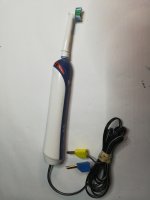Hi all,
my Oral toothbrush's planned obsolescence came up last November. The battery just didn't hold the load anymore and swapping it is possible but well.... I went for a new one (Philips time time). Anyway, I had the idea to use the old brush to clean solder flux, and it works very well. Dispense some isopropyl alcohol on the PCB, start your toothbrush on it and gone is the flux, much easier than by any other method I tried. A second passage eliminate the flux haze and the PCB is nicer than new.
As the battery was dead, I opened the brush as explained here, removed every electronics and the dead battery, and soldered two wires to the motor's taps. It takes 1.2V at about 1.5 - 1.6 A from my lab PSU and works perfectly.
Charles
my Oral toothbrush's planned obsolescence came up last November. The battery just didn't hold the load anymore and swapping it is possible but well.... I went for a new one (Philips time time). Anyway, I had the idea to use the old brush to clean solder flux, and it works very well. Dispense some isopropyl alcohol on the PCB, start your toothbrush on it and gone is the flux, much easier than by any other method I tried. A second passage eliminate the flux haze and the PCB is nicer than new.
As the battery was dead, I opened the brush as explained here, removed every electronics and the dead battery, and soldered two wires to the motor's taps. It takes 1.2V at about 1.5 - 1.6 A from my lab PSU and works perfectly.
Charles
Attachments
Hey Charles,...I opened the brush as explained here, removed every electronics and the dead battery, and soldered two wires to the motor's taps. It takes 1.2V at about 1.5 - 1.6 A from my lab PSU...
thank you sooo much for sharing you excellent ideas!
Regards,
Winfried
Just don't get it mixed up with your actual toothbrush!
I find that rosin tends to accumulate on a toothbrush after a number of uses and its good to rinse it off into a paper towel occasionally with pcb-cleaner, otherwise the brush tends to smear rosin about rather than remove it.
I find that rosin tends to accumulate on a toothbrush after a number of uses and its good to rinse it off into a paper towel occasionally with pcb-cleaner, otherwise the brush tends to smear rosin about rather than remove it.
I have an old AA battery powered toothbrush that I use the same way (Colgate) and the great thing is if the brush is pulled off, the metal "driving" pin can also be used to clean thick flux (light pressure only) in hard to reach places. Old dental tools also have their uses in getting into hard to reach places.
- you have to clean brush with pcb-cleaner after every time you use it (sorry Mark, I don't wanted to be Captain ObviousI find that rosin tends to accumulate on a toothbrush after a number of uses and its good to rinse it off into a paper towel occasionally with pcb-cleaner, otherwise the brush tends to smear rosin about rather than remove it.
- Status
- This old topic is closed. If you want to reopen this topic, contact a moderator using the "Report Post" button.
- Home
- Design & Build
- Equipment & Tools
- PCB cleaning with toothbrush
